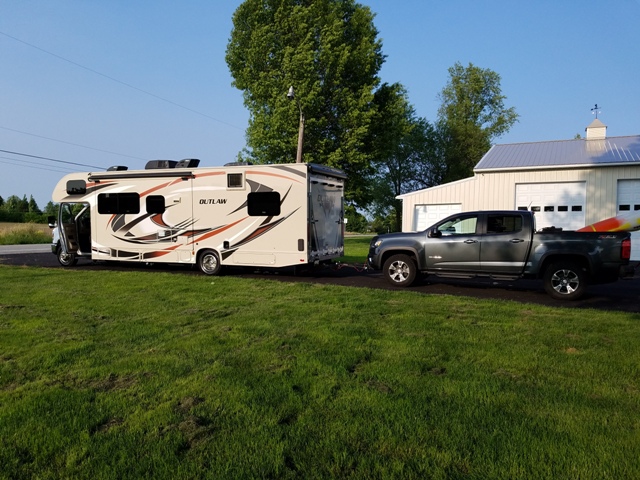What are the options for towing a car behind a motorized RV? There are three common ways available: towing a vehicle ‘four down’, towing a car with the front wheels supported by a tow dolly, and towing a car sitting on a car trailer. There are pros and cons to each of these options which I will discuss in detail below.
Flat Towing (Four Down)

RV flat towing a car
In my opinion, flat towing is the most convenient method of towing a car or truck behind your motorhome. This method is also commonly referred to as ‘four down’ since all four tires of the towed vehicle remain in contact with the pavement. You might also have seen it referred to as dinghy towing.
There are several pros to this method:
- It only takes a few minutes to connect or disconnect the vehicle from the motorhome
- The only thing you have to store while at the RV park is the tow bar (which can generally stay attached to the back of the motorhome).
- Flat towing is the lowest weight option requiring only a tow bar that weights +/- 30 lbs.
- Can utilize the tail lights of your vehicle (for running lights, brake lights, and turn signals).
There are also several cons:
- Requires a vehicle that has been approved by the manufacturer to flat tow.
- It requires modifications to your vehicle such as the installation of a tow bar adapter/bracket, supplemental braking system, and electrical modifications (for the electrical connector and lighting). Our setup was ~3000 dollars in parts alone!
- Additional mileage/wear on all four of your tires.
Can I flat tow my vehicle?
The first thing that needs to be determined is if your car/truck can be used as a dinghy (flat towed). Motorhome magazine has published all vehicles since 1990 that can be used as a dingy (1990-Present Dinghy guides). I would also strongly recommend reviewing your vehicle’s owners manual to verify that there aren’t any additional restrictions. We have a 2015 Chevy Colorado Z71 which I modified to flat tow behind our Class C motorhome.
Dolly Towing

RV towing a car with a dolly
Using a tow dolly is another popular option that allows you to pull any front wheel drive car behind your motorhome. A tow dolly is simply a cart that you drive your car’s front tires up on and secure to the dolly.
Tow Dollies come in one of three braking configurations: no brakes, electric brakes, and hydraulic surge brakes. To be 50-state legal, tow dollies must be equipped with a braking system. Electric brakes require your motorhome to be wired/prepped for trailer towing and a brake controller needs to be installed. Surge brakes, although more expensive self apply when you decelerate.
Depending on which model you get, tow dollies can cost anywhere from 1000-3000 dollars.
There are several pros to this method:
- There are a lot of compatible vehicles
- There are options for any budget
- Very simple to hook up
There are also several cons:
- Tow dollies can weigh 600-800 lbs, making them difficult to move by hand
- Need to determine where to put the dolly while at the camp ground
- May need trailer towing wiring and auxiliary brake controller (for electric brakes)
- May require additional external brake lights on the towed vehicle.
- Additional wear and tear on two of your car’s tires.
Trailer Towing

RV towing a car trailer
If you have a car that cannot be towed by a tow dolly or four down, the only other option is to carry it in a trailer. This will be required for some all-wheel drive cars. Other specialty cars, such as race cars, classic cars, sports cars, etc will also be better suited for trailer towing. Trailers come in many shapes and sizes. They also can either be open (flatbed) or fully enclosed (to keep your car out of the weather).
Nearly all trailers only come with electric brakes which require your motorhome to be wired/prepped for trailer towing and a brake controller needs to be installed.
There are several pros to this method:
- No additional wear and tear on the towed vehicle
- Compatible with all cars/trucks (or even motorcycles)
- No additional lights required for the towed vehicle
There are also several cons:
- Trailers can be expensive (i.e., 2000-10,000+ dollars)
- Trailers are big and storing can be a challenge
- Trailers can weigh 1000-7000+ lbs empty
- May need trailer towing wiring and auxiliary brake controller (for electric brakes)
My towing setups
We have a 2015 Chevy Colorado Z71 which I modified to flat tow behind our Class C motorhome (shown in the picture below). I use a Roadmaster Nighthawk tow bar which is the only model on the market that has integrated lighting, which I really like. I also use a Roadmaster Invisibrake setup to apply the truck’s brakes. I will discuss the full details of this in a separate article in the near future.

Flat towing our 2015 Chevrolet Colorado Z71
I also have an aluminum open car trailer (made by Kiefer) that I use to trailer-tow my 1929 Ford Model A vehicle to specialty events (picture below). I really like this trailer since it only weighs ~1000lbs unloaded. I use a Prodigy P2 brake controller. I also own a race car that I plan on using this setup to take it to the race track. I really like the versatility this set up provides.

Towing my Model A Ford on an open trailer
